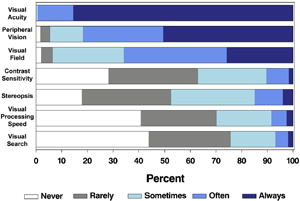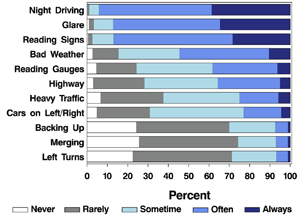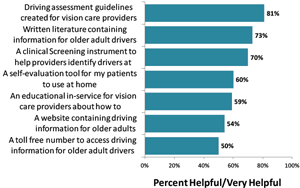You are here
Assessing Driving of Older Adults: Perspectives of Michigan Vision Care Providers
 |
| Vision tests performed by vision care providers. |
 |
| Vision care providers inquiries to older adults regarding certain driving situations. |
 |
| Driving assessment resources ranked by helpfulness |
Despite the relationship between vision, aging, and driving, there is little research on the role that vision care providers (VCPs) play in assessing older patients' driving abilities. A multidisciplinary study team at the University of Michigan (U-M) recently conducted a study to investigate VCPs' attitudes about, barriers to, actions taken regarding, and information used when assessing the driving capabilities of their older adult patients. The study was supported by a grant from the Michigan Center for Advancing Safe Transportation throughout the Lifespan (M-CASTL), a University Transportation Center housed at the U-M Transportation Research Institute.
Drivers over age 65 are the fastest-growing segment of the driving population, and their VCPs–ophthalmologists and optometrists–are playing an increasingly important role in assessing their ability to drive safely. Because vision-related disorders are the primary cause of driving cessation, VCPs are critical members of the health care team in helping older adults continue to drive safely or transition from driver to nondriver status.
The research team found that the majority of VCPs feel it is their responsibility to ask older adult patients about driving, and most do it routinely. VCPs most often test their older adult patients on their visual acuity and peripheral vision, but are least likely to test patients' visual search and visual processing speed. The study also found that VCPs often fail to ask about other factors that might affect the patient's ability to drive safely. Inquiries about glare, driving at night, and reading signs were very common (87 percent), but questions about challenging driving situations–e.g., merging or backing up–or the patient's driving record were infrequent (8 percent).
Research indicates that when older adults lose the ability to drive, there are consequences. These individuals have higher rates of depression and social isolation, more limited access to health care services, and are more likely to need long-term care. With the proper resources, VCPs could work with their patients in modifying their driving habits, which would allow them to drive appropriately and maintain their independence.
VCPs expressed interest in additional driving resources. Prior research stresses the need for practical, easy to administer, clinically valid assessment tools. A standardized set of procedures, including an accurate assessment tool, focused on a planned transition from driver to nondriver status, would benefit clinicians and patients. In this study, the resource that VCPs ranked as the most helpful was driving assessment guidelines created for providers. While some driving assessment resources already exist, it is unclear whether VCPs are unaware of these available resources or are simply dissatisfied with them.
Over 80 percent of VCPs feel confident in their ability to determine whether vision is adequate for safe driving. However, few consider themselves the mostqualified professional to identify unsafe drivers. Only a small number of VCPs (8 percent) communicate driving concerns with the patient's primary care physician or refer patients to driving rehabilitation specialists or driving school. And, when asked about reporting unsafe drivers, some common concerns were negative impact on the doctor-patient relationship, doctor-patient confidentiality, patient's quality of life, and liability issues. In fact, VCPs cite liability risk–both for reporting (24 percent) and not reporting (44 percent)–as a barrier to reporting unsafe drivers.
While VCPs consider driving evaluation an important part of their job, they express uncertainties and concerns about their role in driving evaluation and intervention. There is a need for better communication strategies between VCPs caring for older adults and other health care professionals, as well as between VCPs and patients who need to transition to less risky driving exposure or to nondriver status. Existing resources need to be more widely disseminated, and new driving assessment resources developed and evaluated.
About This Project
Nancy K. Janz, PhD., is Professor and Associate Chair in the Department of Health Behavior and Health Education at the University of Michigan School of Public Health. David C. Musch, PhD., MPH, is Professor in the Department of Ophthalmology and Visual Sciences, Medical School, and Associate Research Scientist in the Department of Epidemiology, School of Public Health, University of Michigan. Rebecca Leinberger, MPH, is a Research Associate in the Center for Managing Chronic Disease at the University of Michigan School of Public Health. Leslie M. Niziol, MS, is a Research Associate in the Department of Ophthalmology and Visual Sciences at the University of Michigan Medical School. Brenda W. Gillespie, PhD., is Associate Director of the Center for Statistical Consultation and Research and Assistant Professor in the Department of Biostatistics, University of Michigan.
